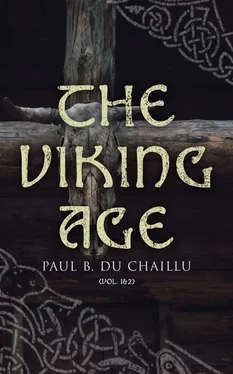Then went Odin
To try word-wisdom
Of the all-wise Jötun.
To a hall he came,
Owned by Ymir’s father;
In went Ygg at once. 22
( As Odin enters he sings —)
Hail, Vafthrudnir,
I have come into thy hall
To look at thyself;
First I want to know,
If thou art a wise
Or an all-wise Jötun.
Vafthrudnir.
Who is the man
That in my hall
Speaks to me?
Thou shalt not
Get out of it
Unless thou art the wiser.
Odin.
I am called Gagnrad , 23
I have now come from my walking
Thirsty to thy hall;
Needing thy bidding
And thy welcome, Jötun;
Long time have I travelled.
Vafthrudnir.
Why standing on the floor
Dost thou speak to me?
Take a seat in the hall.
Then we shall try
Who knows more,
The guest or the old wise one.
Odin.
When a poor man
Comes to a rich one
Let him speak useful things or be silent;
Great babbling
I think turns to ill
For one who meets a cold-ribbed 24man.
We are told in the Völuspa that Odin, in the quest of information, went to visit the Völva, or Sybil, Heid, who was possessed of supernatural powers of knowledge and foresight. She asks for a hearing from the sons of Heimdal, or mankind, and then proceeds to tell what she recollects:—
I remember Jötnar
Early born,
Who of yore
Raised me; 25
I remember nine worlds,
Nine ividi 26
The famous world-tree (Yggdrasil)
Beneath the earth.
The nine worlds were—1, Muspel; 2, Asgard; 3, Vanaheim (home of the Vanir); 4, Midgard; 5, Alfheim (world of the Alfar); 6, Mannheim (home of men); 7, Jötunheim (the home of the Jötnar); 8, Hel; 9, Niflheim.
The first beginnings of all things were apparently as obscure to the Völva as to others; nothing existed before the Creation. The world was then a gaping void (Ginnungagap), and there the Jötun Ymir, or the Hrim Thursar, lived. On each side of Ginnungagap there were two worlds, Niflheim, the world of cold, and Muspelheim, the world of heat.
When Ymir lived
In early ages
Was neither sand nor sea,
Nor cool waves,
No earth was there
Nor heaven above,
There was gaping void
And grass nowhere.
“First there was a home (a world) in the southern half of the world called Muspel; it is hot and bright, so that it is burning and in flames; it is also inaccessible for those who have no odals (or family estates); there the one that sits at the land’s end to defend it is called a Surt. He has a flaming sword, and at the end of the world he will go and make warfare and get victory over all the gods, and burn the whole world with fire” (Later Edda, c. 4). 27
The origin of the Hrim Thursar and the Birth of Ymir, who lived in Ginnungagap, and of Odin, Vili, and Ve, is as follows:
“Gangleri asked, ‘How was it before the kindreds existed and mankind increased?’ Hár answered, ‘When the rivers called Elivagar had run so far from their sources that the quick venom which flowed into them, like the dross which runs out of the fire, got hard, and changed into ice; when this ice stood still and flowed no longer, the exhalation of the poison came over it and froze into rime; the rime rose up all the way into the Ginnungagap.’ Jafnhár said, ‘The part of Ginnungagap turning to the north was filled with the heaviness and weight of ice and rime, and the opposite side with drizzle and gusts of wind; but the southern part of Ginnungagap became less heavy, from the sparks and glowing substances which came flying from Muspelheim.’ Thridi said, ‘Just as the cold and all things come from Niflheim, the things near Muspel were hot and shining; Ginnungagap was as warm as windless air. When the rime and the breath of the heat met so that the rime melted into drops, a human form came from these flowing drops with the power of the one who had sent the heat; he was called Ymir, but the Hrimthursar call him Örgelmir, and the kin of the Hrimthursar have sprung from him.’ Gangleri asked, ‘How did the kin grow from this, or how came it that there were more men; or dost thou believe in the god of whom thou didst tell now?’ Hár answered, ‘By no means do we think him a god; he was bad, and all his kinsmen; we call them Hrimthursar. It is told that when asleep he sweated, and then there grew a man and a woman from under his left arm, and one of his feet begot a son with the other; thence have sprung the kin of Hrimthursar. We call Ymir the Old Hrimthurs.’
“Gangleri asked, ‘Where did Ymir live, or by what?’ ‘It happened next when the hoar-frost fell in drops that the cow Audhumla grew out of it; four rivers of milk ran from her teats, and she fed Ymir.’
“Gangleri asked, ‘On what did the cow feed?’ Hár answered, ‘She licked the rime-stones covered with salt and rime, and the first day when she licked them a man’s hair came out of them in the evening; the second day a man’s head; the third day a whole man was there; he is called Buri; he was handsome in looks, large, and mighty; he had Bör for son, who got Besla, daughter of Bölthorn jötun, for wife, and she had three sons, Odin, Vili, 28Ve; and it is my belief that this Odin and his brothers are the rulers of heaven and earth. We think he is called so. Thus the man whom we know to be the greatest and most famous is called, and they may well give him this name’ ” (‘Gylfaginning,’ c. 5).
The ash tree Yggdrasil is one of the strangest conceptions found in any mythology.
An ash I know standing
Called Yggdrasil ,
A high tree besprinkled
With white loam;
Thence come the dews
That drop in the dales;
It stands evergreen
Spreading over the well of Urd.
Three roots stand
In three directions
Under the ash Yggdrasil;
Hel dwels under one,
The Hrim-thursar under the second,
Under the third “mortal” men.
(Grimnismal).
Under it stands the well of wisdom for a drink from which Odin pledges his one eye.
“Gangleri said: ‘Where is the head-place or holy place of the Asar?’ Hár answered: ‘At the ash of Yggdrasil, where the gods give their judgments every day.’ Gangleri asked: ‘What can be told of that place?’ Jafnhár said: ‘The ash is the largest and best of trees; its branches spread all over the world and reach up over the heaven; three roots of the tree hold it up and spread very widely. One (of the roots) is with the Asar, another with the Hrimthursar where of yore Ginnungagap was; the third is over Niflheim, and beneath it is Hvergelmin, but Nidhög gnaws its lower part. Under the root turning towards the Hrimthursar is Mimir’s well, in which wisdom and intellect are hidden. Its owner is called Mimir; he is full of wisdom, for he drinks from the well of the horn Gjallar-horn. Odin came and asked for a drink of the well, and did not get it till he pawned his eye.”
“What more wonders,” asked Gangleri, “may be told of the ash?” Hár answered, “Many wonders. An eagle sits in the limbs of the ash and knows many things; between its eyes sits the hawk Vedrfölnir. The squirrel Ratatösk runs up and down the ash and carries words of envy between the eagle and Nidhög. Four harts run on the limbs of the ash and eat the buds; they are called Dain, Dvalin, Duneyr, and Durathror. So many serpents are in Hvergelmir with Nidhög that no tongue can number them” (Gylfaginning, c. 16).
Heid in the Voluspa tells about the holy tree, and that the horn of Heimdall is hidden under it till the last fight of the gods. Yggdrasil is watered from the water of the well.
She knows that the blast
Of Heimdal is hidden
Under the bright
Holy tree;
Читать дальше












